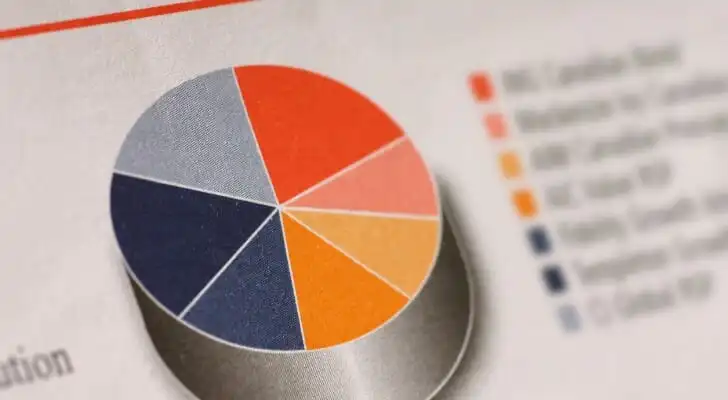Mutual funds are one of the most popular ways to invest, offering everyday investors instant diversification and professional management without needing to pick individual stocks. But while they can be a powerful tool for building long-term wealth, not all mutual funds are created equal, and the benefits often come with trade-offs. Fees, performance variations and differing investment strategies can all impact your returns in ways that aren’t always obvious at first glance. Understanding these dynamics upfront can help you choose the right funds and build a portfolio that truly supports your financial goals.
You can consider working with a financial advisor to guide you through the world of mutual fund investing.
What Is a Mutual Fund?
A mutual fund is a professionally managed investment portfolio composed of one or more asset classes. Think of them as baskets of stocks, bonds, commodities, real estate investments and more.
Mutual fund managers generally determine their asset mix based on a particular investment objective. For instance, a mutual fund that aims for long-term growth may invest entirely in stocks and high-yield bonds.
However, purchasing shares of a mutual fund is different from buying shares of individual stocks and bonds. When you buy shares of a mutual fund, your money is pooled with that of others who invest in the same fund. Therefore, your return is based on the fund’s performance and the proportion of its shares you hold.
Investors may also note that these pooled investments can offer more diversification than other financial investments, such as exchange-traded funds (ETFs). Since mutual funds invest in a variety of securities, the risk is spread across multiple assets. This reduces the impact of any single security’s performance on the overall performance of the fund. However, mutual funds are subject to market volatility, which means that the fund’s value can drop during economic downturns or financial crises.
It is also important to know that mutual funds trade once a day. Their share prices are based on their net asset value (NAV) and computed when markets close each day. The NAV equals the total value of portfolio assets (minus any liabilities) divided by the number of outstanding shares.
However, you cannot always purchase just one mutual fund share. Most mutual fund companies require minimum investments that typically stretch from $500 to $5,000, but requirements depend on the exact fund you choose.
Pros and Cons of Investing in Mutual Funds
Mutual funds offer a number of benefits that make them an attractive investment option for many individuals. One major advantage is dividend potential; investors can receive dividend payments from the fund, which may be reinvested to help accelerate portfolio growth.
Mutual funds also offer built-in diversification by spreading investments across a range of assets, helping to reduce risk. They are generally easy to access and understand, even for beginners, and are managed by professional portfolio managers who make decisions on behalf of the investors.
However, mutual funds also come with drawbacks. Investors have limited control over tax timing and may be subject to capital gains taxes when the fund makes distributions. Additionally, mutual fund trades don’t execute in real time, which can slow down buying or selling compared to individual stocks.
Some funds carry high expense ratios, particularly those above 1.50%, that can eat into your returns over time. There’s also the risk of poor fund management, including excessive trading or questionable end-of-quarter activity designed to improve short-term appearances.
| Pros | Cons |
|---|---|
| Dividend reinvestment potential | Capital gains taxes triggered by fund distributions |
| Built-in diversification | Delayed trade execution |
| Easy to access and understand | High expense ratios in some funds |
| Professional portfolio oversight | Risk of poor management and potentially excessive or reactive trading |
Types of Mutual Funds
It’s important to note that the market currently houses more than 7,000 mutual funds, each with its own asset allocation, objective and investment strategy.
These are the most common types of mutual funds and how they work.
- Stock funds: These funds invest in shares of different companies. Some stock funds focus on investing in companies of a particular market capitalization. This is the total dollar value of a company’s outstanding shares. Large-cap, for example, defines companies with more than $10 billion in market capitalization. Generally, these are well-established firms. Investing in small-cap companies, on the other hand, may involve more risk.
- Bond funds: These funds focus on fixed-income securities and pay interest to their shareholders on a regular basis. These funds may hold different types of debt instruments, such as government, municipal or corporate bonds. The bond fund typically distributes interest payments monthly based on the underlying bonds in the mutual fund. That means the income can change across different payment periods.
- Balanced funds: These funds invest in a mix of stocks, bonds or other securities. Managers typically keep a fixed asset allocation based on the investment strategy of the fund. This can range from conservative to aggressive, depending on the fund’s objective.
How Do Mutual Fund Fees Work?
Mutual fund fees are the costs you pay to have your money professionally managed, and they can significantly influence your long-term returns. Most funds charge an expense ratio, which is an annual percentage taken from your investment to cover management and administrative costs. While the fee is deducted automatically and may seem small, even a difference of a few tenths of a percent can compound over time and meaningfully reduce your portfolio’s growth.
Large fees can make a major dent in mutual fund returns. Oftentimes, the extent of fees involved with mutual funds depends on the fund’s management strategy. Here’s what you should know:
1. Expense Ratios
First, each mutual fund charges an annual expense ratio to cover overall operating and management expenses for the fund. Expense ratios usually range from 0.5% to 1.5% and are generally calculated as a percentage of the income that the fund generates. Thus, your account would face its proportional share, reducing your overall assets.
Additionally, some mutual fund expense ratios include 12b-1 fees to cover marketing and promotional costs. Under the law, this particular component cannot exceed 1%.
The amount that comes out of your account to cover the expense ratio is not explicitly detailed in your statements. However, you can get a good glimpse of what you are paying indirectly for fund expenses if you multiply the expense ratio by the average balance invested in a 12-month period.
2. Load Fees
Mutual funds may also charge load fees when you buy or redeem shares. These fees are separate from the fund’s expense ratio.
Load fees cover commissions paid to brokers and others involved in mutual fund transactions. These can span from 4% to 8% of your investment but cannot be more than 8.5%. Some mutual funds charge front-end loads, which are deducted from your initial investment when you purchase shares.
Other funds charge back-end loads when you sell your shares within a defined time span after you purchase them. Also known as deferred sales charges, these fees generally decrease the longer you hold onto your shares until the fee disappears. For instance, the back-end load may start at 6% if you redeem your shares within a year after purchase. It can then go away after you hold on to those mutual fund shares for six years.
Active vs. Passive Mutual Funds

An actively managed mutual fund aims to outperform the market. The fund manager will likely utilize a wealth of research and analysis theories to build a mutual fund with specific securities that are expected to make substantial returns. It may undergo several transactions in the process. Of course, all this takes money, so active funds tend to charge large expense ratios and loads due to the complex management activity.
Passively managed funds, however, tend to track an index of different securities, such as the S&P 500. This consists of the top 500 U.S. companies with the biggest market capitalization. In other words, the fund aims to mimic the overall return of the S&P 500 by investing in securities that already exist within the index. Therefore, it tries to copy the market rather than beat it.
As you can see, this strategy strips away much of the careful selection involved with active management. As a result, passively managed funds generally charge lower fees than their active counterparts.
While beating the market certainly sounds more lucrative than simply mirroring it, several studies indicate that actively managed funds rarely accomplish their overall goals. However, actively managed funds may be able to better hedge against risk due to their tendency to buy and sell securities when deemed necessary.
Finding the Best Mutual Funds
Choosing the best mutual funds starts with understanding your financial goals, time horizon and tolerance for risk. A fund that’s ideal for long-term growth may not suit someone looking for stability or income, so aligning the fund’s strategy with your personal objectives is essential. Reviewing the fund’s investment style, whether it tracks an index or uses active management, can also help you determine whether its approach fits your broader portfolio.
Performance matters, but it shouldn’t be the only factor you evaluate. Look for funds with consistent, long-term results rather than those that only shine in short bursts, and compare their track record to relevant benchmarks. Fees play an equally important role, as high expenses can erode returns over time, even in well-performing funds. Lower-cost options like index funds can offer strong, steady performance without the added drag of hefty management fees.
Finally, consider the fund manager’s experience, the fund’s holdings and how it fits alongside your existing investments. A diversified portfolio should include funds that complement one another rather than overlap too heavily. If you’re unsure which funds best match your needs, a financial advisor can help you evaluate your options and build a mix that supports your long-term financial goals.
When Are Mutual Funds a Good Fit for Your Portfolio?
Mutual funds can be well-suited for investors looking for simplicity, diversification and long-term growth without the burden of managing individual securities. They are often ideal for retirement accounts, such as IRAs or 401(k)s, where the focus is on broad market exposure and tax-deferred growth over decades. In this context, mutual funds provide an easy way to invest in different asset classes with limited oversight required from the investor.
They also make sense for individuals who prefer a hands-off approach or lack the time or expertise to actively manage a portfolio. Investors seeking exposure to professionally-selected securities, whether through active or passive management, may find that mutual funds offer a balance of convenience and oversight. Additionally, mutual funds may be beneficial for those contributing to long-term savings plans, education accounts or income-generating portfolios.
However, mutual funds may not be the best fit for tactical investors, short-term traders or those prioritizing intraday control or ultra-low-cost investing. In such cases, exchange-traded funds (ETFs) or individual securities might offer more flexibility and real-time trading capability.
Ultimately, mutual funds are best used as core holdings in a broader strategy, especially for investors with long-term goals and a preference for steady portfolio construction.
Factors to Consider Before Investing in Mutual Funds
When determining whether a mutual fund is right for you, your financial situation and your investment goals, there are several things to consider. Here are some that might be at the top of your list:
- Your investment goals: Whether you’re looking for growth, income or capital preservation, be sure to identify your financial goals. Different mutual funds focus on various strategies, such as equity funds for growth, bond funds for income or balanced funds for a mix of both.
- Risk tolerance: Mutual funds vary in risk levels. Equity funds, particularly those focused on smaller companies or emerging markets, tend to have higher volatility compared to bond or money market funds.
- Expense ratios and fees: Mutual funds come with fees, which can include expense ratios, management fees and sales charges (loads). Lower-fee funds tend to outperform higher-fee ones over the long term, as fees can significantly impact returns.
- Performance history: While past performance doesn’t guarantee future results, it is still worth examining a fund’s long-term track record to assess its consistency over time. Look for performance over at least five to 10 years, but do not rely solely on short-term trends.
- Fund manager and strategy: Consider the experience and reputation of the fund manager. Active funds rely on the manager’s expertise to beat the market, so researching their track record and investment approach is important. Passive funds, like index funds, track a specific market index and usually have lower fees.
- Minimum investment requirements: Many mutual funds have minimum initial investment amounts, which can range from a few hundred to several thousand dollars. Make sure the fund’s minimum fits within your budget.
- Tax efficiency: If investing in a taxable account, consider the tax implications of the mutual fund. Some funds are more tax-efficient than others, distributing fewer capital gains, while others may generate higher tax liabilities.
- Liquidity and redemption policies: Most mutual funds offer liquidity, allowing you to redeem your shares easily, but some may have restrictions or redemption fees for early withdrawals. Ensure the fund’s liquidity meets your needs, especially if you may need access to your funds quickly.
- Dividend and distribution policies: Some mutual funds pay out dividends or distribute income regularly, which can be an important source of cash flow for income-focused investors. Others may reinvest earnings within the fund. Know how the fund handles distributions and how that fits with your income needs.
Bottom Line

Mutual funds can be an effective way to build long-term wealth, offering diversification and professional management in a single investment. But choosing the right funds requires careful evaluation of fees, performance history, investment strategy and how each fund complements your overall portfolio. By understanding these factors, and seeking guidance when needed, you can select mutual funds that align with your goals, minimize unnecessary costs and strengthen your path toward financial success.
Tips on Mutual Fund Investing
- Because of the complexity of mutual funds, it can be a good idea to seek the guidance of a financial advisor. Finding a financial advisor doesn’t have to be hard. SmartAsset’s free tool matches you with vetted financial advisors who serve your area, and you can have a free introductory call with your advisor matches to decide which one you feel is right for you. If you’re ready to find an advisor who can help you achieve your financial goals, get started now.
- Mutual fund fees can take huge chunks off your returns, which is why you should research investing costs with laser precision. But one good place to start might be with index funds. These passively managed funds generally charge lower fees than actively managed ones.
Photo credit: ©iStock.com/benedek, ©iStock.com/Jirapong Manustrong, ©iStock.com/LiudmylaSupynska
